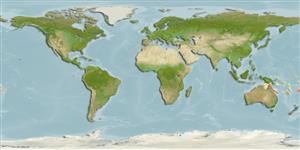Klassifizierung / Names
Namen | Synonyme | Catalog of Fishes(Gattung, Arten) | ITIS | CoL | WoRMS | Cloffa
>
Eupercaria/misc (Various families in series Eupercaria) >
Labridae (Wrasses) > Cheilininae
Etymology: Cirrhilabrus: Latin, cirrus = curl fringe + Greek, labros = furious (Ref. 45335); squirei: Named for Lyle Squire of Cairns Marine..
Environment: milieu / climate zone / depth range / distribution range
Ökologie
seewasser riff-verbunden; tiefenbereich 28 - 65 m (Ref. 118208). Tropical
Western Pacific: Australia.
Size / Gewicht / Alter
Maturity: Lm ? range ? - ? cm
Max length : 5.6 cm SL Männchen/unbestimmt; (Ref. 118208)
Kurzbeschreibung
Bestimmungsschlüssel | Morphologie | Morphometrie
Rückenflossenstacheln (insgesamt) : 11; Rückenflossenweichstrahlen (insgesamt) : 9; Afterflossenstacheln: 3; Afterflossenweichstrahlen: 9; Wirbelzahl: 25. This species is distinguished by the following characters: D XI,9 (a female paratype with XII,9); A III,9; pectoral rays 15; lateral line scales 17+7; median predorsal scales 5; horizontal rows of scales on cheek 2; gill rakers 13-15; body depth 2.85-3.40 in SL, width 1.95-2.15 in body depth; head length 2.75-2.90 in SL; snout length 4.1-4.4 in HL; short pelvic fin, not reaching base of the anal fin, 4.15-4.65 in SL; rounded to truncate caudal fin in females and moderately to strongly lunate in males, caudal concavity as great as 0.8 in head; large eye, orbit diameter 3.55-3.90 in HL; colour in life with body yellow shading yellow white on abdomen, 5 irregular red orange bands, yellow dorsal fin with spinous portion having dusky spots on outer part, black on the first membrane, a central lavender band becoming black toward soft rays and soft portion with a black central band abruptly translucent posteriorly, the anal fin yellow, soft portion with a broad lavender black central band becoming narrower on the spinous part, the caudal fin yellow with 7 dusky black tongue-shaped extensions on the innermost rays; colour when preserved, males pale yellow and bands mentioned above on dorsal, anal and caudal fins are dusky to black, paired fins translucent (Ref. 118208).
Life cycle and mating behavior
Maturities | Fortpflanzung | Spawnings | Egg(s) | Fecundities | Larven
Walsh, F.M., 2014. Cirrhilabrus squirei, a new wrasse (Perciformes; Labridae) from the Great Barrier Reef and Coral Sea, Australia. aqua, Int. J. Ichthyol. 20(3): 123-130. (Ref. 118208)
IUCN Rote Liste Status (Ref. 130435)
Bedrohung für Menschen
Harmless
Nutzung durch Menschen
Tools
Zusatzinformationen
Download XML
Internet Quellen
Estimates based on models
Phylogenetic diversity index (Ref.
82804): PD
50 = 0.5000 [Uniqueness, from 0.5 = low to 2.0 = high].
Bayesian length-weight: a=0.01585 (0.00707 - 0.03555), b=2.95 (2.76 - 3.14), in cm total length, based on LWR estimates for this (Sub)family-body shape (Ref.
93245).
Trophic level (Ref.
69278): 3.3 ±0.4 se; based on size and trophs of closest relatives
Widerstandsfähigkeit (Ref.
120179): hoch, Verdopplung der Population dauert weniger als 15 Monate. (Preliminary K or Fecundity.).
Fishing Vulnerability (Ref.
59153): Low vulnerability (10 of 100).
